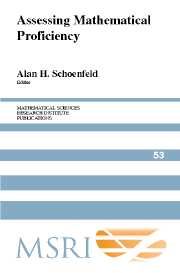Book contents
- Frontmatter
- Contents
- Preface
- Acknowledgments
- Section 1 The Big Picture
- Section 2 Perspectives on Mathematical Proficiency
- Section 3 What Does Assessment Assess? Issues and Examples
- Section 4 The Case of Algebra
- Section 5 What Do Assessments Assess? The Case of Fractions
- Section 6 The Importance of Societal Context
- Epilogue What Do We Need to Know? Items for a Research Agenda
- About the Authors
- Subject Index
- Author Index
- Task Index
Chapter 11 - Assessing the Strands of Student Proficiency in Elementary Algebra
Published online by Cambridge University Press: 06 July 2010
- Frontmatter
- Contents
- Preface
- Acknowledgments
- Section 1 The Big Picture
- Section 2 Perspectives on Mathematical Proficiency
- Section 3 What Does Assessment Assess? Issues and Examples
- Section 4 The Case of Algebra
- Section 5 What Do Assessments Assess? The Case of Fractions
- Section 6 The Importance of Societal Context
- Epilogue What Do We Need to Know? Items for a Research Agenda
- About the Authors
- Subject Index
- Author Index
- Task Index
Summary
In order to assess something, you have to have some idea of what that something is. Algebra means many different things in today’s schools (for a discussion, see [RAND 2003, Chapter 4]). In particular, the study of algebra is often blended with the study of functions. Although it is true that the notion of a function is lurking behind much of beginning algebra, and that there is an algebraic aspect to many of the tasks we want our students to carry out with functions, the conglomeration of algebra and functions has considerably muddied the waters in the teaching of algebra. Therefore, I’d like to spend some time clarifying my own stance before talking about how to assess proficiency. In the process, while acknowledging other possible uses, I will use the word “algebra” to mean the study of algebraic expressions and equations in which the letters stand for numbers. I include in this study consideration of the relationship between the algebraic form of expressions and equations and properties of their values and solutions. I make a distinction, however, between this study and the study of functions.
In the progression of ideas from arithmetic to algebra to functions, there is an increase in abstraction at each step, and the increase at the second step is at least as large as that at the first. In the step from arithmetic to algebra, we learn to represent numbers by letters, and calculations with numbers by algebraic expressions. In the step from algebra to functions we learn of a new sort of object “function” and represent functions themselves by letters. There are two complementary dangers in the teaching of algebra, each of which can cause students to miss the magnitude of this step.
A complementary danger is that algebra appears as a sort of auxiliary to the study of functions. It is common to use multiple representations of functions in order to make concrete the notion of a function as an object in its own right. Functions are represented by graphs, tables, or verbal descriptions, in addition to algebraic expressions. By looking at the same object from different points of view, one aims to foster the notion of its independent existence. In this approach, algebra provides one way of looking at functions, but functions are not regarded as purely algebraic objects. This solves the problem of students not seeing the forest for the trees, but risks them not being able to see the trees for the forest. Overemphasizing functions when teaching algebra can obscure algebraic structure, and too much attention to graphical and numerical approaches can subvert the central goal of thinking about symbolic representation.
Information
- Type
- Chapter
- Information
- Assessing Mathematical Proficiency , pp. 157 - 162Publisher: Cambridge University PressPrint publication year: 2007
Accessibility standard: Unknown
Why this information is here
This section outlines the accessibility features of this content - including support for screen readers, full keyboard navigation and high-contrast display options. This may not be relevant for you.Accessibility Information
- 1
- Cited by
